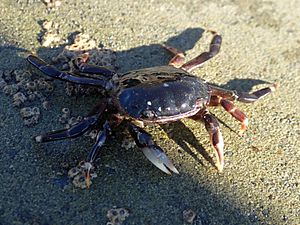Hemigrapsus sexdentatus facts for kids
Quick facts for kids Hemigrapsus sexdentatus |
|
|---|---|
 |
|
| Scientific classification | |
| Kingdom: | |
| Phylum: | |
| Subphylum: | |
| Class: | |
| Order: | |
| Infraorder: | |
| Family: |
Varunidae
|
| Genus: |
Hemigrapsus
|
| Species: |
H. sexdentatus
|
| Binomial name | |
| Hemigrapsus sexdentatus (H. Milne-Edwards, 1837)
|
|
| Synonyms | |
|
|
The Hemigrapsus sexdentatus is a type of marine crab. It is also known as the common rock crab or common shore crab. You can find this crab living along the southern coasts of New Zealand. It belongs to a group of crabs called the Varunidae family.
Contents
Learning About the Common Rock Crab
Scientists sometimes change the names of animals as they learn more about them. This crab used to be called Hemigrapsus edwardsii. After more studies, scientists found that its correct name should be H. sexdentatus.
What Does the Common Rock Crab Look Like?
Male common rock crabs can grow to about 55 millimeters (2.2 inches) wide. Females are a bit smaller, reaching about 45 millimeters (1.8 inches) wide.
These crabs have a special square-shaped shell, which is called a carapace. If you look closely, you'll see two small "teeth" on each side of their shell. Their claws, known as chela, are usually short. However, male crabs can have much larger claws.
Common rock crabs are mostly grey. They have two main color patterns for their patches:
- Pale form: These crabs have large patches that can be light to dark red.
- Dark form: These crabs have smaller patches that are dark purple to blue-black.
The color on the top of their shell is usually darker near the front. It gets lighter and more spread out towards the back. The underside of the crab is white. Their legs and claws are white with red or purple colors that match the patches on their shell.
Reproduction and Life Cycle
Common rock crabs have both male and female sexes. You can tell males apart by the small bulges of white muscle that stick out near their claws. Females do not have these bulges.
Female crabs carry their eggs during the southern hemisphere winter months, from April to September. A female can carry up to 26,000 tiny eggs, which are about 0.35 millimeters in size.
Scientists have studied how these crabs reproduce. They found that male crabs often compete with each other to find a mate. Larger males are usually more successful at breeding. They can even take a female away from a smaller male crab. Females also have some control over when they are ready to mate, especially when males are around.
Even when they are just tiny embryos, these crabs start to develop special ways to control the salt and water in their bodies. This process is called osmoregulation.
How Do Common Rock Crabs Behave?
H. sexdentatus crabs are very quick and move fast. However, they are usually easy to handle if you need to. They often come out from under rocks or out of cracks, especially at night, to look for food.
These crabs follow the tides. They are most active when the tide is high and the water is in. When the tide is out, they tend to be quieter.
While scientists haven't studied the social behaviors of H. sexdentatus in great detail, a similar crab, the H. nudus, shows many social behaviors. These behaviors help them defend their food, their space, and their mates. Crabs of the same size tend to be more aggressive with each other. Crabs that live in an area will defend their home against new crabs trying to move in.
Where Do Common Rock Crabs Live?
The common rock crab lives in the intertidal zone along the rocky shores of New Zealand. This is the area between the high and low tide marks. You can find them all along the coast of New Zealand. However, they are more common on the southern shores. Another crab, Ozius truncatus, takes their place in the northern parts.
They prefer sheltered, rocky, and muddy shores. You can find them from the high tide line down to about the mid-tide line.
Common rock crabs eat sea snails. They use their strong claws to break open the snail shells. They also eat algae that drifts in the water.
Not many fish eat these crabs. However, they have been found in the stomachs of fish like rig, red cod, and sea perch. Other creatures like Cephalopods (like octopuses and squids) and tiny crab larvae called zoea also sometimes prey on them.
Images for kids


